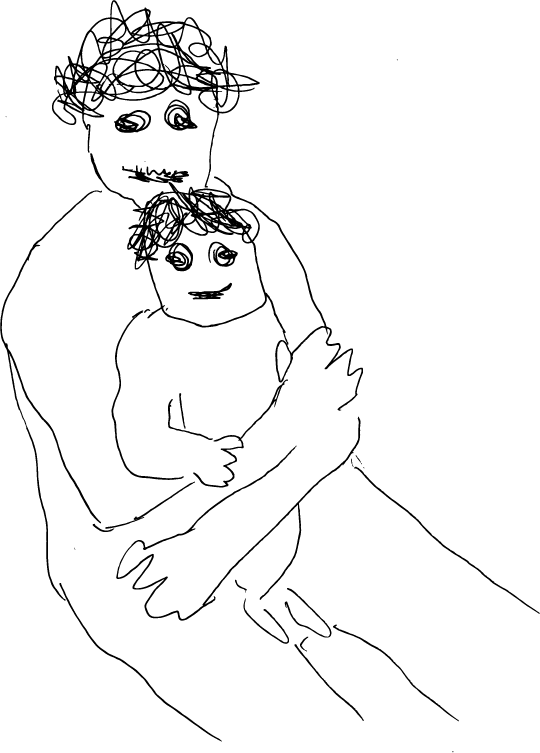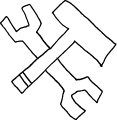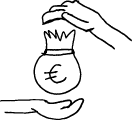INTRODUCTION
I was born in 2019. My parents took good care of me. We got through the COVID-19 crisis well. But our economy and the planet changed. Even humans changed - their behaviour, their lifestyles, their habits, their everyday life. At least my parents told me that story; I can't remember - I was still a baby.
Ohhhh, I just found an image of me and my dad on my archive-DNA (I'll talk about that later).

We're sitting on concrete floor.
Back in 2020 almost everything was built using concrete, but today, in the year of 2051 every building is constructed out of wood. Actually one of the biggest players on the market is ↗CREE. A company based in Dornbirn, Vorarlberg. I don't want to go into details right now. 😉 (Oohhh, yeah, emojis are still here and used more than ever.)
I want to split up my story into following parts:
→ Infrastructure
→ Technology
→ Mobility
→ Individuals
→ Economy
→ Design
Let's start. It'll be awesome.

INFRASTRUCTURE
As I mentioned above, in 2051 almost every building is made of wood.
Wood has succeeded over concrete and brick because it is cheaper to buy and process, while at the same time it grows again and again and binds CO2. Modules are made which can be assembled individually. In doing so, the living space created adapts to the respective situation of the residents. In 2051 this is done automatically - as soon as I enter an apartment (alone) the modular room system has adapted to my wishes and needs in advance.
You are probably still sitting in offices, aren't you? It's 2020 after all. 😉
In 2051 there are no more conventional office buildings, no more large rooms. The repetitive, recurring work on documents - in justice, in medicine, ... - is done by machines that are housed in former open-plan offices.
Roads still exist. For bicycles and other means of transport on the ground. Many sidewalks are now made of solar-sensitive material so that they can produce electrical energy and generate data (temperature, precipitation, frequency of use) at the same time.
Fossil fuels are completely dispensed with in energy production. Solar energy supplies the required megawatt hours. ↗Ramez Naam already dared to make a cautious forecast in this regard in 2020. In retrospect, he was not so wrong. In 2051, one megawatt hour of solar energy will cost € 0.008.
In general, less energy is consumed. Emerging and developing countries also recognized the benefits of energy-saving measures.
In summary, the existing infrastructure is doing well in 2051. The rural exodus has not been as severe as predicted. Yes, partly locally, there has been a counter-trend: people moved to the countryside when digital infrastructure was available.
However, large shopping centres are either completely closed or empty. Occasionally there are vacancy concepts, but often huge ruins - like knight's castles in 2020 - stand in the landscape. Former petrol stations are also scenting their way through the countryside. For them, no conclusive post-use concept has been found.
Let's move on to the next chapter.

TECHNOLOGY
You're still looking at a physical screen, right? Yeah, I know, it's still 2020.
Occasionally you can still find physical displays; where there is only one direction of communication - only to the recipient. Otherwise there is no surface in the sense of a plane. Interaction with machines happens in space, be it with gestures, voice or, more recently, but unfortunately still quite expensive, directly via brain-computer interface. Of course there are concerns about this, but a broad discourse throughout society is desired in 2051.
↗Ben Ewans - my father was very fond of his analyses - wrote in 2020 that a so-called VR winter will break out. In other words, the technology for VR and AR had already been there, but nobody knew what to do with it. It was similar to the way the Internet used to be. (😂 "Internet" - such an outdated word.) VR and AR are still in use, but the technology is getting old and will soon be phased out.
Apple Glasses were the predecessor for Retina Chips. Small optical cells that are planted directly on the retina of the eyes - similar to contact lenses in 2020, only not as dry and scratchy. With these chips, information is superimposed directly into the field of vision. The software recognizes objects, places, weather, traffic, etc. - But for people a strict data protection order was enforced. Man and his data is the most valuable in 2051.
Also because you can now store information directly on your own DNA. A free, limitless, biological memory that every human being possesses. A few patches are enough and you can store your most important data for eternity in your own DNA. In 2020 there were still USB sticks, weren't there? Crazy.
Let's get to my passion. Influenced by the artistic activities of my parents, I am also addicted to photography - in a positive sense. I have been taking light field photography for about a decade now. All settings happen afterwards; focus, aperture, exposure. One picture has about 10GB - not that much, right? How was that in 2020? I can even remember ↗my father taking analogue photos. Totally exciting.
Speaking of my father. He was always engaged with the upcoming future. In 2019, he did a thesis as part of his studies on the subject of "Man and/or Against Machine". His work was also shown at ↗Ars Electronica 2019 - at that time a big annual exhibition for digital art and media in Linz. I dug up the two clips - they were stored on some ancient hard drive. Here you can see them; on the left the cut of the machine, on the right my father's.
↗Meanwhile all films are cut by an algorithm. You can't tell the difference - but linear motion picture consumption is not the hottest thing in 2051 anymore.
Ohhh, and I found a quote in my digital library. It's ancient, but it's still valid, isn't it?
«Technology is a tool. It does what we tell it to do. So it's only as good as our intentions. If we want technology to free us, we have to make it so that it does. If we want it to support the status quo, it will. So it's only as good or bad as we make it. That is why diversity is so essential, so that we can imagine what these tools can be used for.»
Dori Tunstall in «The Politics of Design» by Victor Papanek

MOBILITY
Bicycle, bicycle, bicycle. Everything, objects and subjects, move by bicycle. The e-bike makes up the lion's share, but there are now alternative drives. And because some e-bikes are already oldtimers, Austria's first e-bike museum recently opened around the corner. It is housed in the old Simplon production halls. Unfortunately, Simplon has opted for incremental innovation, i.e. the development of an existing concept rather than a redefinition of the business and product strategy. That went wrong. In the middle of the 2030s the company was bought by ↗Vanmoof - mainly know-how in automatic frame building was acquired. The site in Hard was closed or, more recently, converted into a museum. Yes, people still go to museums. At least they want to get the impression of an overview over small topics.
Because we humans have always moved - as hunters and gatherers unconsciously, later for reasons of resources - society in 2051 is as mobile as in 2020.
There are no more big SUVs like in 2020; after all, the dinosaurs were the largest when they became extinct. 🦕
Many alternative options to motorised private transport have become established. Cablecar, hyperloop, self-driving taxis, passenger- and load drones. Mobility has more or less changed from a physical product to a service on demand. Mobility as a Service - MaaS for short.
Aircraft burning massive amounts of kerosene have become unaffordable for about ten years. There was no need for regulations or bans. The decades of fossil-burning traffic are over.
In a city it can be loud. Near a drone stop, sometimes louder than in 2020 next to a highway. But the air is all the cleaner for that. The CO2 and nitrogen oxide emissions from traffic in 2051 are heading towards zero. This is also the reason for much less respiratory and lung diseases. We save ourselves a lot of money. But that brings us to another topic.

INDIVIDUALS
We're still human. No cyborgs, no chipped clones.
We have feelings. We experience fear and joy, hate and love. But we've left the ↗Society of Singularities. The urge for self-expression, even self-exploitation, was and is not so prevalent in my generation. We already developed a distinctive media competence in childhood, which I unfortunately - partly still - painfully miss in people who are about the same age as my parents.
As a society, we are developing more and more into a knowledge society. Everyone collects this knowledge individually and can pass it on to the collective - at their own discretion and at their own expense. ↗The first steps in this direction have already been taken by 2020. But compared to the possibilities of today, that was peanuts back then.
I am doing well. I am pursuing my passion, photography, and I can make a good living with it. Besides the basic income, which finally became reality in 2037 for the whole European Union (yes, it's still here and Great Britain is back in it), I earn enough money with photography to live well. But money no longer has the value it had in 2020.
In the end, money is a story. This has been doubted over the years, but no other concept or solution has been found. People continue to trust money as a means of payment, but its status and potential are expressed in other values. Time, for themselves and others, plays a crucial role in this.
My father was a big fan of ↗Wolf Lotter. Below is a quote from this wise man. Still apt, too. Thank you Dad for showing me such literature. I'm sorry, but we are still human. And there is a great deal of humanity in the year 2051. ❤️
«The training and promotion of creativity, fantasy and imagination is not pedagogical child's play, but basic work for the knowledge society, as important as reading, writing and arithmetic. They are the basis for the ability to recognize, which precedes making possible and understanding.»
Wolf Lotter in «Innovation. Streitschrift für barrierefreies Denken.»

ECONOMY
If I'm not completely wrong, but I think around your time, i.e. 2020, probably also due to COVID-19, companies started to question their value creation strategies. What happens if we as a company waste our essential resources? It's not just about ecological aspects, it's about economic issues. If I no longer have what I sell, what do I sell?
In 2051, only companies that include these questions in their business plan from the outset will survive. Surprises and problems are dealt with offensively. Teams of experts independent of the company deal with them and share the solution collectively. Everyone has access, even the biggest competitors. What somebody does with the information gained is up to the company itself.
Thus the question ↗"Who?" plays an even greater role than at the beginning of the 2020s. Organizations do not hire on the basis of completed studies or online courses, but on the basis of skills and knowledge.
Asia, especially China, recognized the human factor and its excellent combination of skills and knowledge earlier and thus overtook the USA, which was the world power by the mid-2020s. For twenty years China was a pioneer - country of innovation, country of news, country of development. Also socially, which in turn led to bloody revolts. Today China is a democratic republic.
The long underestimated continent of Africa is turning into a hidden champion. Educational offensives in the field of digital education like in Kenya promoted the worldwide establishment of software companies from the Silicon Valley of Kenya. (Silicon Valley was it called in 2020, wasn't it?)
Europe has always been a bit "slow". But that was and is still a good thing. The discourse as itself was always valued high. There was a lot of broad and long talk, but therein lies also the quality of a democracy. Decisions on data protection, basic income and new currencies (local, alternative means of payment) often took years. And by the time they came into effect, they were already outdated again. Permanent beta, then.
There was no permanent beta for cash. In 2040, that was finally over. Nowadays, every person (in the EU, China is a little different) has a personal account, which is managed decentrally using block chain technology. Money transfers are always possible - there is no need for a central gatekeeper (banks) as in 2020. In 2051 there are still banks, but their business model has changed dramatically. Away from switching and managing, towards a transparent marketplace.
In summary, capitalism in its basic features is still the dominant economic form in 2051. A capitalism that has adapted itself to man and nature and with it provides for a better world. Investments for the future - the credo of today's economy.

DESIGN
And finally, I'll finish up with the section on design.
Design has changed enormously. In 2020 and the following years - as my father often told me - there was more and more discussion about what design is, what it is useful for, who needs it.
Based on this discourse, many small subcategories of design developed: visual flat design (including UI design, graphic design, motion design, ...), visual physical design (including interior design, fashion design, ...), bodiless design (UX design, service design, ...), business design (design-driven innovation, strategy design, ...).
My father established himself in the field of business design. His holistic approach helped many companies question their business model and develop visions that set them apart from the competition and make them unique in the market. He trusted in the approach of System Centered Design. Derived from Habermas' philosophy - the truth lies in the relationships of subject to subject, subject to object and object to object - he was able to convince clients to ↗say goodbye to User Centered Design if they want to drive radical innovation.
Many "ordinary" design activities are nowadays done by software, because in the end design - in the sense of visual design - is a decision to make. There are still a few exceptions, but these designers are more art-oriented.
↗Even the problem-solving approach that was still widespread in the 2020s is now being handled by machines. Rather, what is needed at present are people who decide which problems are relevant or whether they are problems at all.
In the last decade, the general discipline of design has become entangled with highly popular philosophy and now deals with questions of meaning and being. In doing so, designers make a valuable contribution to the immediate implementation (visual, disembodied or conceptual) of the questions posed and the answers to them.
All in all, it can be said that design has evolved. It is no longer - as my father often mentioned - the profession of the beautician. It is much more the subject of thinkers and people who want to understand. But there are some things I don't understand either... that's nice too. 😉
Speaking of ↗my father.
There's someone knocking on my virtual room door right now. I think it's my dad.
He's probably telling me how it all was back in the days. How he applied to the ↗UBS Y Think Tank, how he mapped out a future scenario and so on...
I'll see you later. I'll see you soon.
Bye. Take care. 👋
Look forward to the future.
It's gonna be good. 👍
